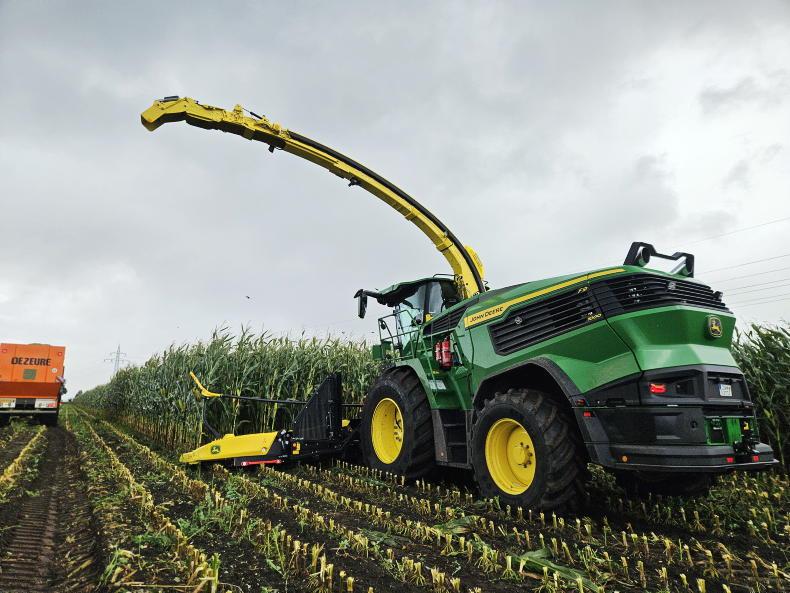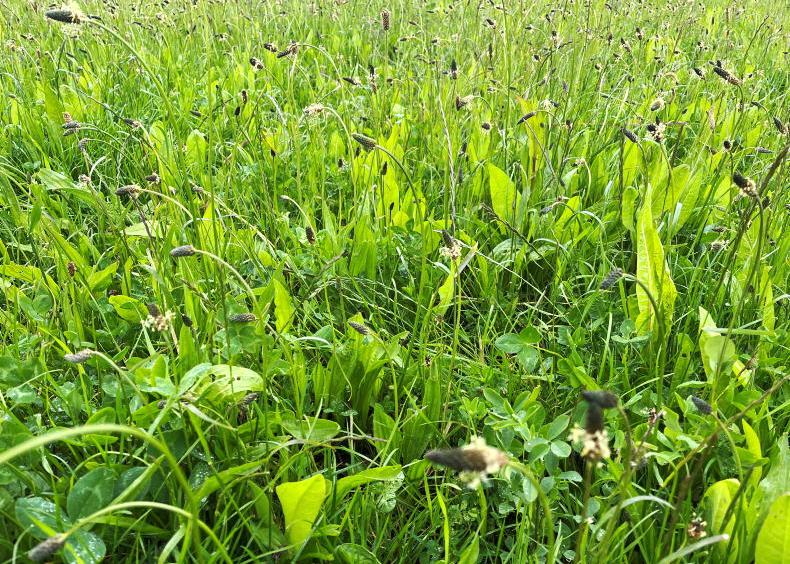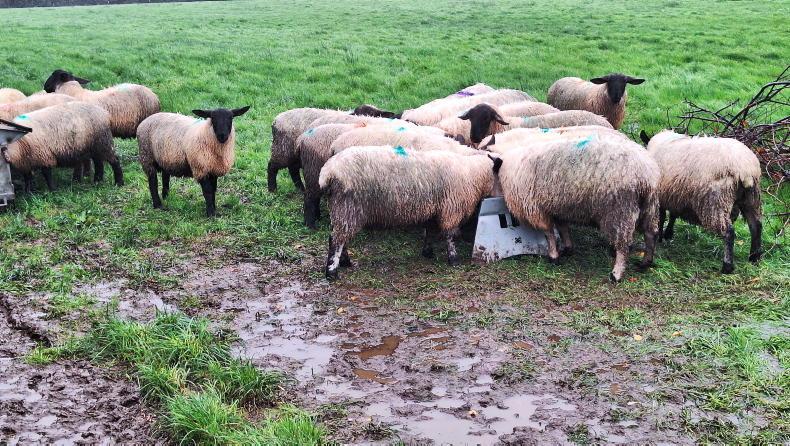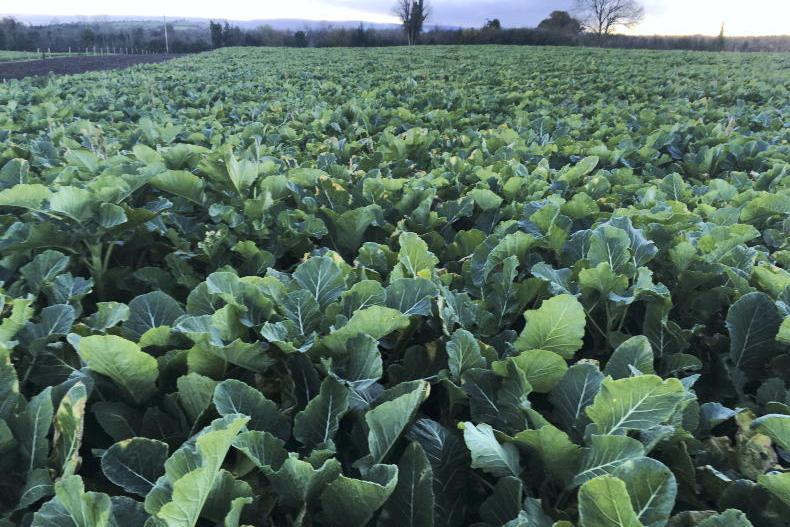After witnessing a lull for a number of years after dairy expansion, forage crops have gained a mini resurgence in popularity, with drystock and dairy farmers seeing the benefits from a liveweight gain point of view, while tillage farmers see the benefits that animals have on soil health, with forage crops also aiding in improving soil structure.
However, certain precautions need to be taken to prevent digestive upsets, or fatalities, when it comes to grazing the crop.
Introduce animals to brassicas slowly: introduction to forage crops should take place on a phased basis. Allow stock to graze initially for one to two hours, before building up to full-time access at day 10. An alternative fodder source should be available at all times.
Mineral supplementation: brassica crops are low in essential minerals – namely, iodine, selenium, copper and cobalt. Animals must be supplemented with these minerals prior to grazing forage crops, with bolusing being the surest way that animals receive adequate levels of each mineral.Inclusion of fibre: brassicas should not form any more than 70% of the diet. Grass lieback areas can be used as alternative sources of feed, provided there is sufficient grass available to form the additional 30% of the animal’s diet. Where there are insufficient grass supplies, or the lieback area comprises stubble land, then hay, straw or silage should be accessible to animals. Ideally, these bales should be spaced out prior to grazing and shortly after sowing to prevent the need for machinery to enter fields during the winter months. Always ensure constant access to fresh water: despite their low dry matter (around 12%), grazing animals must always have access to clean, fresh water. It is important to consider trough position when allocating forage crops. It is not ideal that animals would continually have to travel over grazed ground to access crops as this will lead to excessive poaching.Grazing in-situ
and allocation
The most suitable option is to graze the brassica crops in-situ, where infrastructure allows. A good electric fence and easy access to water are two critical points to consider.
Where lambs are being strip grazed, it may be necessary to use more than one strip wire, which requires cutting or flattening of the crop.
With the colder months, animals will require a higher percentage of their body weight, approximately 3%, when grazing outdoors.
Calculating forage crop allocation
To ascertain how much forage crop should be allocated, some simple calculations are required.
Animal weight and numbers
Forty weanling heifers at 275kg @3% of their body weight = 330kg DM/day.150 store lambs at 35kg @3% of their body weight = 157.5kg DM/day.The next step is to calculate the volume of forage crop in the field. This is most accurately done by cutting and weighing.
1. Measure a 1m2 plot with average crop density in it.
2. Cut the crop using a garden shears and place into a large bag.
3. Weigh the crop and calculate as below:
Weight of crop in kilos x 0.12 (dry matter percentage of crop) x 40,000 = tonnes DM/ha, eg 1.8kg x 0.12 x 40,000 = 9.6 tonnes DM/ha.
Assuming 30% of our animal intake is coming from silage/hay/straw, the above example of 40 weanling heifers will require 231kg DM of forage crops per day.
Dividing our requirement (231kg) into our supply (9.6 tonnes), we will have sufficient forage crop available for 41 to 42 days of grazing in a 1ha paddock and should be divided as such.
In relatively square fields, a good measure can be to count the number of fence posts along the length of a field and use this as a guide, eg 30 posts in a field at 4m spacing = 120m long, meaning the allocation should be approximately 3m wide per day.
Grazing in these narrow strips will avoid wastage and increase the amount of fresh feed being presented to animals.
Depending on utilisation, allocations can be reduced or increased.
When allocating forage crops, ensure there is no frost present before giving animals a new strip as frost can increase the nitrate levels in forage crops which can lead to nitrate poisoning.
Type of fields
Ideally, forage crops should only be grown on dry, free-draining and relatively level fields. Where forage crops are grown on sloped fields, then grazing should start from the top of the slope to reduce any soil runoff. Excessive poaching should be avoided as this is in breach of cross compliance.
Rules for different movement scenarios
Where stock are moving to a separate farm under a grazing agreement, there may be a requirement to notify the Department of Agriculture about these movements and this will be dependent on what type of farm the stock are moving to. The following are the main three movement scenarios regarding sheep and Department rules concerning each.

Ideally, bales of silage should be placed in the field before a crop is well established to avoid traffic in a field.
Movement to lands with no stock
Where the movement is to a farm with no stock, such as moving sheep to graze green cover on tillage farms, for example, sheep can be moved to and from temporary grazing without dispatch documents and without notifying the Department.
Movement to farms where livestock is present
In the case of sheep moving to lands where there is already livestock present, the Department must be notified. As there is no change in ownership, the onus lies on the owner of the sheep to notify the Department. This can be carried out by completing a dispatch document and sending the pink copy to the local district veterinary office (DVO).
Notification of a return from temporary grazing can be completed by sending the white copy of the dispatch document and clearly stating “return from temporary grazing”.
Movement to a separate land block on a livestock holding
A common exception to the above scenario is where sheep are moved to a holding that has livestock, but sheep are being moved to a separate land block to where the ANC applicant’s animals are located. In this case, sheep can be moved to a parcel or outfarm block without notifying the Department, provided there is no livestock on any part of the land sheep are being moved to.
Cattle movements
- Where cattle are being moved on to a holding where there are cattle already present, then this must be carried out using the AIM system by completing the NBAS31A form. This also applies to B and B arrangements.
- Where cattle are moved on to a holding where there are no cattle, then a Record 4 form must be completed and submitted to the Department of Agriculture prior to movement.
- Fodder crops must be fed alongside a source of fibre such as hay, straw or silage.
- Mineral supplementation and clean sources of fresh water are essential for animal health when grazing.
- Allocating daily strips will improve utilisation.
After witnessing a lull for a number of years after dairy expansion, forage crops have gained a mini resurgence in popularity, with drystock and dairy farmers seeing the benefits from a liveweight gain point of view, while tillage farmers see the benefits that animals have on soil health, with forage crops also aiding in improving soil structure.
However, certain precautions need to be taken to prevent digestive upsets, or fatalities, when it comes to grazing the crop.
Introduce animals to brassicas slowly: introduction to forage crops should take place on a phased basis. Allow stock to graze initially for one to two hours, before building up to full-time access at day 10. An alternative fodder source should be available at all times.
Mineral supplementation: brassica crops are low in essential minerals – namely, iodine, selenium, copper and cobalt. Animals must be supplemented with these minerals prior to grazing forage crops, with bolusing being the surest way that animals receive adequate levels of each mineral.Inclusion of fibre: brassicas should not form any more than 70% of the diet. Grass lieback areas can be used as alternative sources of feed, provided there is sufficient grass available to form the additional 30% of the animal’s diet. Where there are insufficient grass supplies, or the lieback area comprises stubble land, then hay, straw or silage should be accessible to animals. Ideally, these bales should be spaced out prior to grazing and shortly after sowing to prevent the need for machinery to enter fields during the winter months. Always ensure constant access to fresh water: despite their low dry matter (around 12%), grazing animals must always have access to clean, fresh water. It is important to consider trough position when allocating forage crops. It is not ideal that animals would continually have to travel over grazed ground to access crops as this will lead to excessive poaching.Grazing in-situ
and allocation
The most suitable option is to graze the brassica crops in-situ, where infrastructure allows. A good electric fence and easy access to water are two critical points to consider.
Where lambs are being strip grazed, it may be necessary to use more than one strip wire, which requires cutting or flattening of the crop.
With the colder months, animals will require a higher percentage of their body weight, approximately 3%, when grazing outdoors.
Calculating forage crop allocation
To ascertain how much forage crop should be allocated, some simple calculations are required.
Animal weight and numbers
Forty weanling heifers at 275kg @3% of their body weight = 330kg DM/day.150 store lambs at 35kg @3% of their body weight = 157.5kg DM/day.The next step is to calculate the volume of forage crop in the field. This is most accurately done by cutting and weighing.
1. Measure a 1m2 plot with average crop density in it.
2. Cut the crop using a garden shears and place into a large bag.
3. Weigh the crop and calculate as below:
Weight of crop in kilos x 0.12 (dry matter percentage of crop) x 40,000 = tonnes DM/ha, eg 1.8kg x 0.12 x 40,000 = 9.6 tonnes DM/ha.
Assuming 30% of our animal intake is coming from silage/hay/straw, the above example of 40 weanling heifers will require 231kg DM of forage crops per day.
Dividing our requirement (231kg) into our supply (9.6 tonnes), we will have sufficient forage crop available for 41 to 42 days of grazing in a 1ha paddock and should be divided as such.
In relatively square fields, a good measure can be to count the number of fence posts along the length of a field and use this as a guide, eg 30 posts in a field at 4m spacing = 120m long, meaning the allocation should be approximately 3m wide per day.
Grazing in these narrow strips will avoid wastage and increase the amount of fresh feed being presented to animals.
Depending on utilisation, allocations can be reduced or increased.
When allocating forage crops, ensure there is no frost present before giving animals a new strip as frost can increase the nitrate levels in forage crops which can lead to nitrate poisoning.
Type of fields
Ideally, forage crops should only be grown on dry, free-draining and relatively level fields. Where forage crops are grown on sloped fields, then grazing should start from the top of the slope to reduce any soil runoff. Excessive poaching should be avoided as this is in breach of cross compliance.
Rules for different movement scenarios
Where stock are moving to a separate farm under a grazing agreement, there may be a requirement to notify the Department of Agriculture about these movements and this will be dependent on what type of farm the stock are moving to. The following are the main three movement scenarios regarding sheep and Department rules concerning each.

Ideally, bales of silage should be placed in the field before a crop is well established to avoid traffic in a field.
Movement to lands with no stock
Where the movement is to a farm with no stock, such as moving sheep to graze green cover on tillage farms, for example, sheep can be moved to and from temporary grazing without dispatch documents and without notifying the Department.
Movement to farms where livestock is present
In the case of sheep moving to lands where there is already livestock present, the Department must be notified. As there is no change in ownership, the onus lies on the owner of the sheep to notify the Department. This can be carried out by completing a dispatch document and sending the pink copy to the local district veterinary office (DVO).
Notification of a return from temporary grazing can be completed by sending the white copy of the dispatch document and clearly stating “return from temporary grazing”.
Movement to a separate land block on a livestock holding
A common exception to the above scenario is where sheep are moved to a holding that has livestock, but sheep are being moved to a separate land block to where the ANC applicant’s animals are located. In this case, sheep can be moved to a parcel or outfarm block without notifying the Department, provided there is no livestock on any part of the land sheep are being moved to.
Cattle movements
- Where cattle are being moved on to a holding where there are cattle already present, then this must be carried out using the AIM system by completing the NBAS31A form. This also applies to B and B arrangements.
- Where cattle are moved on to a holding where there are no cattle, then a Record 4 form must be completed and submitted to the Department of Agriculture prior to movement.
- Fodder crops must be fed alongside a source of fibre such as hay, straw or silage.
- Mineral supplementation and clean sources of fresh water are essential for animal health when grazing.
- Allocating daily strips will improve utilisation.











SHARING OPTIONS